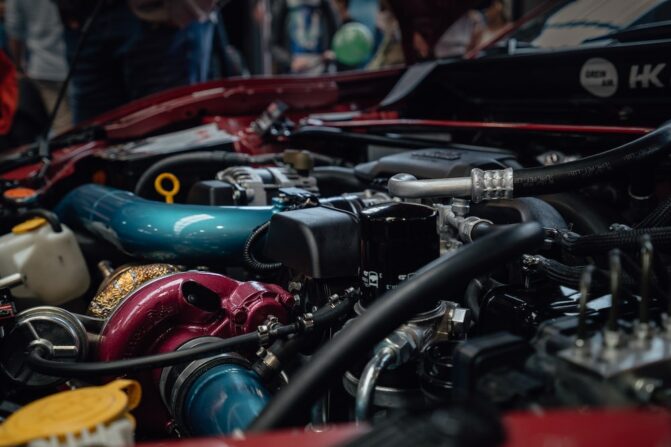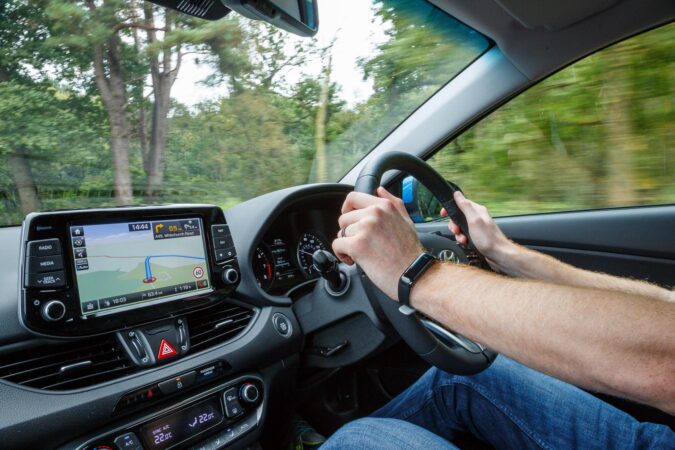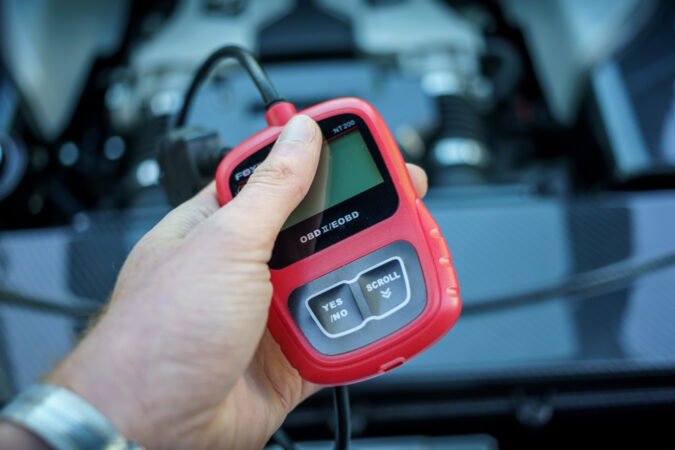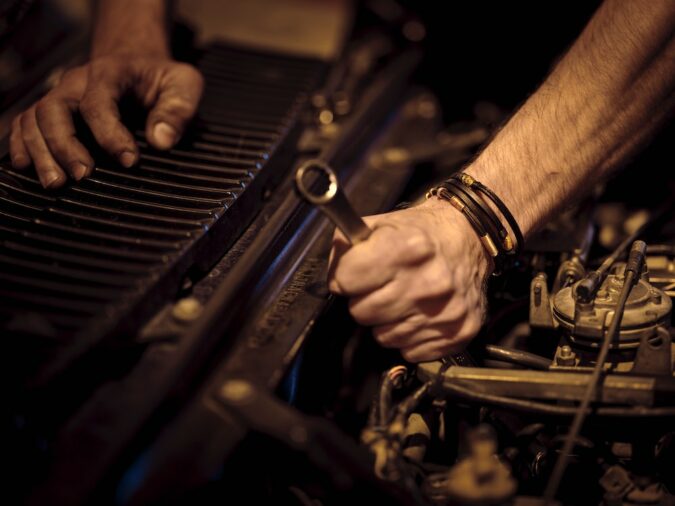Fuel and air are key ingredients of the internal ignition process. The right amount of fuel and air must enter the combustion chamber for the ignition process to be successful. An error code stored in your vehicle’s computer is never a good sign. For the P0172 code, the underlying problem is quite serious.
The engine control unit (ECU) generally controls the flow of fuel and air in the chamber. This is essentially the central computer in charge of all the internal workings of a car, including the amount of fuel it gets into the combustion chamber.
However, if the computer malfunctioned at any point or some other issue messed up the fuel injection system, your vehicle’s engine might receive more or less fuel than it needs to run. This makes the ECU store trouble code P0172.
Understanding The P0172 Code
Combustion engines function by burning a blend of fuel and air of approximately 1 to 14.7 – 1 part fuel to 14.7 parts air. If the ratio goes under 14.7, we call that a “rich” mixture. On the other hand, if the air goes over 14.7 parts, that is termed a “lean” mixture. In either of these cases, the combustion engine becomes inefficient and gas mileage takes a hit.
A Rich Mixture: Not enough air and too much fuel.
A Lean Mixture: Not enough fuel but too much air.
For an engine to operate correctly, the ECM has to measure the level of oxygen in the exhaust using an O2 sensor, performing adjustments throughout the blend by injecting more or less fuel to make sure the ratio of fuel to air is right.
The ECM has to function under certain parameters. If the adjustments are too large to make, it triggers the error code P0172. The O2 sensor detects there is too little oxygen in the exhaust and most of the fuel is being removed by the O2 sensor to keep the ratio optimum.
This error code bears a lot of resemblance to P0175. For some scanning tools and a few cases, the vehicle might display both codes at the same time. Vehicles running “rich” are harmful to humans and the environment. The contaminants can be poisonous and pollute the air nearby.
So, in a nutshell, what does P0172 stand for?
- Definition: There isn’t enough air or too much fuel in Bank 1.
- Problem Severity: MODERATE – Driving in this condition for a prolonged period can result in internal engine damage.
- Repair Urgency: You have to get this code checked as soon as you can to avoid harm to pistons, spark plugs, and catalytic converters.
- Diagnosis: When diagnosing error code P0172, it is critical to finish the whole diagnostic process. Many owners would replace the oxygen sensor or air-fuel sensor when they get a poor reading, but the origin of the problem could also be a vacuum leak or faulty or dirty mass airflow sensor.
Possible Reasons Behind P0172 Code
Similar to any other OBD-II code, the error code P0172 can be a result of a variety of issues. There isn’t a guaranteed way to narrow down what’s causing the issue apart from inspecting the critical components handling the fuel mixture constantly. These are some of the possible reasons you are getting the error code from your vehicle’s engine.
- Leaking fuel injector
- Contaminated engine oil
- Blocked air filter
- Excessive fuel pressure because of bad fuel pressure regulator or blocked fuel return line
- Saturated carbon canister
- The clogged air intake system
- Buildup in or damage to these exhaust parts: exhaust pipe, muffler, and catalytic converter
- Poor O2 sensor
- Circuit concerns, like damaged wiring or loose connections
- Issues with other sensors like mass airflow sensors and coolant temperature sensor
- Exhaust leak
- Problems with the PCM, like a need for software update
Common Symptoms Of The P0172 Code
Your vehicle can burn through more fuel if the engine is running on a rich fuel mixture. Thanks to the complicated measures the PCM/ECM has to employ to make sure the fuel system remains balanced; the driver might not observe any symptoms apart from an illuminated Check Engine Light. In extreme scenarios where one or more components have failed, signs can range from moderate to engine-damaging.
The exhaust system is also in a vulnerable position as unburnt fuel in the exhaust lines could ignite and damage components such as the catalytic converter. Keep an eye out for these symptoms to be warned about these problems beforehand:
- Lack of power in the engine
- Misfiring cylinders
- Illuminated CEL
- Rolling or rough idle
- Acceleration hesitation
- Poor fuel economy
- A strong odor of fuel from the exhaust
How To Diagnose A P0172 Error Code
When your vehicle displays error codes P0172 and P0175, it means the car’s computer failed to automatically regulate the air/fuel mixture. Code P0172 applies to Bank 1 whereas the other code applies to Bank 2. For P0175, it mainly works for V6 and V8 engines, since the four-cylinder engines generally feature a single bank. However, there are a few exceptions and high-performance six-cylinder engines.
When the trouble code says the fuel system is too rich, this implies that the computer is pulling in more fuel, which is termed long-term fuel trim if it continues for too long. The ideal measurement is around 1%-2%. When code P0172 sets in place, this means the fuel trim stands at around -15% (it could also be -30%).
If this happens, the engine’s computer registers that the fuel system or oxygen sensor is in bad condition and lets you know.
To diagnose P0175 and P0172, you have to examine the scanner and look for the least of long-term fuel trim’s 3 ranges. Also, look at the idle reading – Unloaded: 3,000 RPM and with 50% load the very minimum: 3,000 RPM. Then, write down the free frame information of the code and understand the range(s) that failed. Recognize the conditions in which the failure happened.
1. Test The MAF Sensor
Start the engine and allow it to idle, and then check the Barometric Pressure reading displayed on the scan tool. You are at sea level if the reading comes to 34.5 Hg, meaning that the Air Flow Meter is defective since the reading is suggesting that you are 4,000 feet under sea level.
Once the MAF sensor registers the barometric reading, the tool automatically fixes air density before “over-reporting” the true level of air entering the engine. This happens because the barometric pressure sensor is a part of the sensor.
Sometimes, dirt, oil, and/or dust can gather on the sensing wire of the MAF, leading to error codes being stored. The easiest fix is to clean the MAF sensor. However, it must be replaced at one point.
Make sure the air filter, as well as the enclosure, is clean. Change or clean the enclosure as required to maintain the condition of the MAF.
2. Tips To Diagnose P0172
Long-term fuel trim will slowly move towards short fuel trim until the latter comes back to zero range. Therefore, when you are looking for the reason behind an error code P0172, and if you’re using an OBD scan tool to check live data, look at the long fuel trim first, as this indicates where the short fuel trim diverted to when the problem happened.
If you think you have fixed whatever was triggering the issue, take out the battery cable to reset the adaptive memory (fuel trim) so everything returns to 0. When the scan tool screen shows “Closed Loop,” zero should be the number the short fuel trim remains close to. If it starts to move from the zero range the second the PCM/ECM enters Closed Loop Fuel Control, the problem persists.
Any values of fuel trim after 10 or negative 10 signals a problem. Code P0172 and/or P0175 are likely to be stored if the LTFT dips below negative 20 to 25.
3. Common P0172 Diagnosis Mistakes
Completing the whole diagnostic procedure when diagnosing error code P0172 is important. Don’t jump to conclusions and replace the O2 sensor or air-fuel sensor the moment you get a bad reading – it could just be a faulty or dirty mass airflow sensor. Reading and evaluating freeze frame data and the fuel trims is essential in properly diagnosing these trouble codes.
How To Fix The P0172 Code
Fortunately, there are quite a few routes to take to repair the code P0172, but the best way would be determined by the exact cause. You might end up just having to clean apart, but in many cases, a replacement is also required. Thus, there isn’t a one-size-fits-all solution for this problem. You must start by properly diagnosing the code, as mentioned above, and then do any necessary repairs.
And of course, keep in mind that vehicles are unique. When diagnosing and fixing OBD-II error codes, you should have a peek at the factory repair details for your particular application. Different solutions are required for different causes. These are a few of the most common solutions to this problem:
- Inspect the PCV vacuums and hoses for damages, change components if needed.
- Clean the MAF sensor. Consult with your owner’s manual to be sure of where the MAF sensor is located. The best way to clean this sensor is to remove it and use an electronic cleaner or a brake cleaner. Be careful, though, and try to not damage it. Also, make sure to completely dry the component before reinstalling it.
- Examine the fuel lines for leaks, cracks, and pinches.
- Check the fuel pressure.
- Check for dirt in the fuel injectors. Have them professionally cleaned or changed, or you can use fuel injector cleaner to clean them yourself.
- Examine the exhaust leak situated by the 1st O2 sensor. Although unlikely, this can still be the reason behind the problem.
How Much Does It Cost To Fix Error Code P0172?
If you bring your vehicle to an auto shop for troubleshooting, the majority of shops will begin with one hour of “diagnosis time’ (the time value of labor spent diagnosing the particular issue). Based on the labor rate at that shop, this generally costs anywhere between $75 to $150. Most shops can be expected to charge this diagnosis rate if you get them to perform the fixes for you.
From there, you will get an accurate estimate on the repair of error code P0172 from the shop.
Possible Repair Costs For P0172
For repairs linked to the P0172 error code, you may have to perform multiple fixes to solve the underlying problems, thus, solving the main issue. For every possible repair, the cost of repair estimate includes the price of necessary components and the price of labor needed to perform the repair.
- Clean MAF Sensor – $100
- Vacuum Leak – $100 to $200
- Replace MAF Sensor – $300
- Fuel Pressure Regulator – $200 to $400
- Fuel Pump – $1,300 to $1,700
- Oxygen Sensor or Air Fuel Sensor – $200 to $300.
The Connection Between Air-Fuel Mixture And OBD Codes Stored In A Car
Ideally, an internal combustion engine should consume a fuel blend of 1:14.7. This means that for every 1 part of fuel, there must be 14.7 parts air in the mixture – not by volume, but by weight. An engine uses almost 9,000 gallons of air per gallon of fuel.
Fuel is always measured by weight when it comes to engineers working on cars. Injectors get their ratings through how many pounds of fuel an hour they can inject within a specific pulse width.
If the fuel/air ratio is balanced at 1:14.7, the engine is combusting as cleanly as possible. In scientific terms, each hydrocarbon molecule is “marrying” 2 oxygen molecules. CO2 is formed through this process, and this gas is fed to the grass by the road. Well, plants do need CO2 to survive. Carbon dioxide is much heavier than air and sits close to the ground. Plus, the trees need it to live.
When the HC gets to “marry” the oxygen in the combustion chamber (triggered by the combustion spark), it generates heat very suddenly for the inert nitrogen (comprising 78% of the entire air charge) to expand, and the piston is pushed down to activate the crankshaft.
If the fuel/air ratio is imbalanced and there is excessive fuel, every hydrocarbon molecule will get with only one oxygen molecule, creating carbon monoxide, or CO, a potentially poisonous gas. Not adequate air and too much fuel is termed rich – not enough fuel and too much air are deemed lean.
The PCM/ECM along with the oxygen sensor work in harmony to ensure that the combustion chamber has a steady balance of the mixture. If the mixture strays too far from the ideal blend, the computer stores a code.
Similarly, if the fuel-air mixture is way too out of balance, a little bit of oxygen will be consumed along with tons of hydrocarbon, which is unused fuel that forms sooty debris on spark plugs.
Can I Calculate Air-Fuel Ratio Using Downstream Oxygen Sensors?
The computer reads the fuel-air ratio by observing the upstream oxygen sensor(s). However, in case the PCM/ECM realizes that the upstream oxygen sensors have gotten unreliable, the downstream sensors will be utilized for fuel/air ratio calculations. Many mechanics might not be aware of this and would thus refuse to believe it – beware of that.
Will The P0172 Code Clear Automatically?
Sadly, no, the P0172 trouble code will not clear automatically after the problem has been repaired, just like any other trouble code. Thus, you have to use an OBD scanner and connect it to your car. Once the vehicle has been linked to the scanner, rescan the vehicle. You should get an inactive error message saying P0172. Go ahead and clear this error using the tool so the trouble code disappears permanently.
Try to scan the vehicle once more to ensure that codes have gone completely.
What Is Fuel Trim?
Fuel Trim is how the ECM/PRM responds to the O2 sensors once the system is in a “Closed Loop” fuel control, which means it is using the oxygen sensor input as a determinant in doing constant Fuel Trim regulations.
The fuel control system goes into “Open Loop” for the Wide Open throttle option and begins in Open Loop with a cool engine. Alternatively, that response is applicable if the ECM/PCM finds a serious problem in some other component of the system.
To start, there is a Long Fuel Trim and a Short Fuel Trim. Fuel Trim is used by the ECM/PCM to depict the fuel mixture adjustment measure and you can see it on a scan tool. Oxygen sensor signals can be gauged with a digital voltmeter or a scope, but you cannot measure Fuel Trim in any other method except the live data on the scan tools.
The ECM/PCM has a programmed answer to the perceived lean or rich conditions reported by the O2 sensor(s) and that is the Fuel Trim.
About Short Term And Long Term Fuel Trim
Long-term and short-term fuel trim are generally shown as a percentage; you can see the scale as a number line, with positive digits on the right, negative values on the left, and zero in the center. The correct fuel trim on healthy systems should display single digits a bit above or under zero and it must always be jumping slightly up and down below and above zero.
The oxygen sensor shifts between lean and rich when things are operating correctly, with 0.5 volts at the middle of the voltage swing. And the fuel trim swings alongside the oxygen sensor.
When you get the scan tool to show a Short Term Fuel Trim’s histogram just over the oxygen sensor trace to compare, you will see that the short fuel trim resembles a “saw tooth” design, and the oxygen pattern looks somewhat like “humps of a camel.” The O2 sensor will move between 2 to 5 times every second on a healthy system, generally more at elevated RPMs.
As the O2 moves up, the fuel trim goes down – when there is a change of direction in the O2 pattern, the Fuel Trim follows suit, which is constantly moving in the opposite direction of the O2 signal. Again, this response to the O2 sensor activity and input is from the fuel trim, which is a sign of combustion.
If the oxygen swings and stays there (high up), the fuel trim responds by starting to fix the negative part of zero and continue correcting until the oxygen sensor shows that the negative correction has reverted the oxygen sensor to regular behavior. In this case, the P0172 code is set by the ECM/PCM.
Is It Safe To Drive With A P0172 Code?
When this error code is activated, you will not be able to drive your vehicle for a long time. While it would be possible to drive for shorter distances, avoiding and delaying the repairs can exacerbate the damages and make the decay reach one of the priciest parts of a vehicle, the catalytic converter.
You are probably ignoring the error code completely unaware of the problems it can create shortly. Did you know that replacing a catalytic converter can set you back up to $3,000, if not more for luxury cars? No owner wants to deal with that.
Thus, right after you see any of the signs of an error code P0172, you have to bring your car to a professional mechanic so they can solve the issue.
Conclusion
The P0172 code is a constant reminder of the need to have the right balance between fuel and air in your vehicle’s engine. After all, how well a vehicle performs depends on it. We suggest dealing with the error code as soon as it pops up to avoid doing major damage to other components of the car.
You will have to shell out big bucks to repair these parts later on. Think $3,000 for a catalytic converter replacement (and once you’ve found a good catalytic converter replacement shop near me or catalytic converter repair near me and where to find a catalytic converter near me)!
This article contains all necessary information about the P0172 code like the main reasons, signs, along with recommended repairs and replacement costs.




